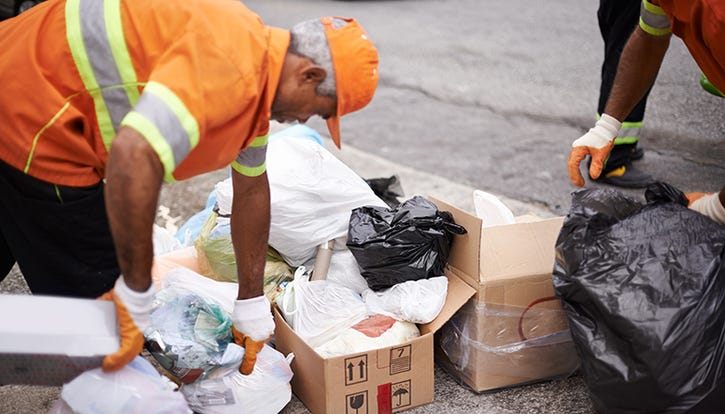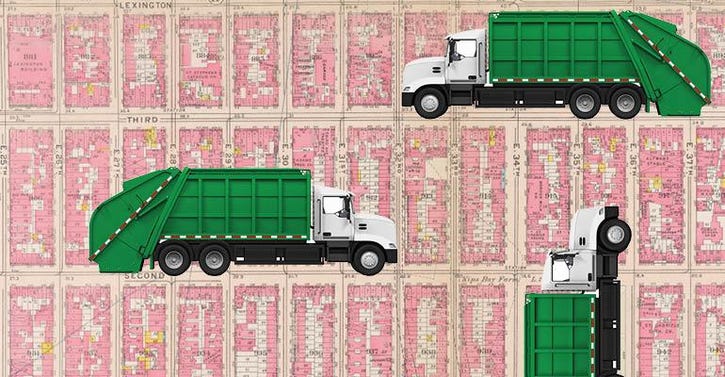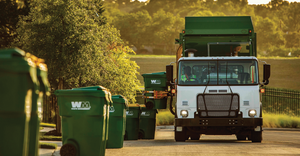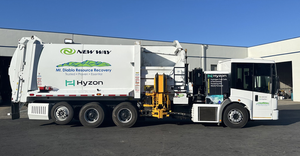Dissecting NYC’s Commercial Waste Zones Bill
The bill, Intro. 1574-A, was signed into law by New York City Mayor Bill de Blasio on November 20.

New York City is getting a makeover. Not to the subway system or to tourist-packed destinations like Times Square but to its commercial waste and recycling collection system, which handles upwards of 3 million tons of waste and recycling annually.
The overhaul is the result of Intro. 1574-A, legislation that will divide New York City into 20, non-exclusive zones, each serviced by up to three carters. The bill, which has been in the works for about four years, was officially signed into law by New York City Mayor Bill de Blasio on November 20.
While some see this revamp as a way to create a safer, more efficient collection system, others have expressed concerns that it presents large risks for the city as well as an unfair advantage to haulers of a certain size.
Waste360 has dissected the new commercial waste zones bill to better understand how it will affect the future of commercial waste and recycling in New York City.
What the Commercial Waste Zones System Entails
The commercial waste zones system will be administered by the City of New York Department of Sanitation (DSNY) in partnership with the Business Integrity Commission. It will apply to the collection of commercial refuse, recyclables and source separated organic waste; construction and demolition waste, medical waste and other types of waste will continue to be collected and managed under current regulations.
The system was developed through extensive stakeholder engagement and about four years of studies and analyses. It builds on New York City’s zero waste goals outlined in the mayor's OneNYC plan and aims to create a safer and more efficient collection system that provides high-quality, low-cost service to New York City businesses, according to Sanitation Commissioner Kathryn Garcia.
Under the new program model, New York City will be divided into 20 zones, each serviced by three carters. In addition, five carters will be selected to provide containerized collection service citywide for dumpsters and compacters used by large facilities such as hospitals, office buildings and stadiums.
Each carter can be awarded only 15 zones in total, and each zone can have up to two subcontractors.
The carters will be selected during a request for proposals (RFP) process in May 2020 that weighs companies’ past compliance with regulations as well as their proposals to improve safety, reduce waste, increase recycling and reuse, provide exceptional customer service, transition to zero-emission fleets and achieve zero waste goals.
According to Garcia, carters that seek to invest in infrastructure and technology that promote program goals including clean vehicles, safety, technology and sustainable waste management facilities will receive favorable consideration during the selection process.
“The competitive procurement will ensure that the selected carters would be those able to provide a competitive price while also meeting and exceeding standards for service, safety, infrastructure investment and efficiency and demonstrating a strong commitment to zero waste goals,” said Garcia during a briefing call on November 20.
“As a result to the RFP process, we will enter into an agreement with the selected carters that are authorized to operate in their respected zones. These agreements will also include other requirements related to the program goals,” she added.
Some of the other requirements include:
Carters must provide safety training programs to build a culture of safety within the commercial waste industry and ensure that workers know how to perform their job safely. Specifically, carters will be required to provide a minimum of 40 hours of worker safety training to all drivers and helpers who collect waste on city streets. (The bill also creates a worker safety task force comprising representatives appointed by the administration and council to review best practices for safety and make recommendations for additional requirements and regulations.)
Carters must comply with all existing local, state and federal labor laws including minimum wage, fair labor standards and paid sick leave.
Carters are required to use city programs that promote local hiring of qualified applicants for any job openings. (DSNY will establish a displaced worker list for programs to utilize.)
Carters must dump their waste only at facilities that meet safety and health standards. Carters must outline the transfer, processing and final disposal locations of all materials collected in their initial waste management plan required for proposals.
Carters are required to provide written service agreements to all of their customers so they only pay for what they use.
Carters must comply with customer service requirements, such as itemized monthly billing and a customer service hotline and website. If a business is unhappy with its service, it can opt to “fire its carter” and authorize a service agreement with one of the other two carters in the zone.
Carters are required to provide recycling collection to the businesses they serve and organics collection to the businesses that request it. They must offer these services at a discount when compared to refuse collection services to incentivize businesses to recycle and compost as much as possible.
Carters are required to maintain a fleet that’s safe and able to perform all applicable collection services for their customers. In addition, they must work toward the bill’s targets of 50 percent zero-emissions trucks by 2030 and 100 percent zero-emissions trucks by 2040.
What Challenges will be Addressed
In New York City, more than 100,000 commercial establishments generate upwards of 3 million tons of waste and recycling annually. These materials are collected via approximately 90 private haulers. These haulers, operating primarily at night, can have as many as 1,000 stops to service and cover all five boroughs on a single, long route, while as many as 50 carters may service a single neighborhood.
The commercial waste zones system aims to combat some of the challenges associated with the city’s collection system, such as truck traffic, noise and roadway wear and tear.
“Commercial waste zones will address many of these challenges,” said Garcia during the briefing. “[The system] will reduce private garbage truck traffic by more than 50 percent and cut associated air pollution and greenhouse gas emissions. It will create new, stronger requirements for health, safety and customer service; incentivize recycling and investment in cleaner trucks and facilities; and provide New York City businesses high-quality service built upon the principal of fairness and accountability.”
“The industry is dangerous, polluting and unsustainable, and it creates some very real quality of life issues for neighborhoods across the city in every borough,” she added. “Since 2010, private garbage trucks have killed 28 people on New York City streets … and that’s just the trucks collecting the kinds of waste we’re addressing through commercial waste zones. Waste collection is dangerous work and one of the top five most dangerous jobs in the U.S., but for New York City private haulers, long and exhausting shifts combined force workers to cut corners and further risk their lives and the lives of others. The industry also lacks transparency, fails to protect workers’ rights and struggles to meet the city’s recycling requirements. Basically, it’s broken.”
Under the new commercial waste zones system, DSNY and program participants will work to overcome these challenges as well as any challenges that may arise in the future.
What Concerns have been Raised
In New York City, there has been an ongoing debate regarding the safety of commercial haulers. Both sides say they ultimately have the same goal: to improve safety in the waste and recycling industry and to remove the industry from the most dangerous jobs list. But the emphasis on how to get there is divergent, and the establishment of commercial waste zones has raised concerns amongst some members of the industry.

In 2016, Kendall Christiansen, executive director for New Yorkers for Responsible Waste Management, a consortium of 25 locally owned and operated waste service providers, told Waste360 that “the idea of commercial waste collection zones does not appeal to the waste and recycling industry because the industry is committed to having an open market competitive system to serve the public. This system would only allow larger companies to compete, which is something the industry has always resisted.”
Over the years, he’s worked alongside other opposers to push New York City to reconsider its commercial waste zones plan.
In February 2018, after the mayor allegedly held closed-door meetings, six major business groups called on the New York City Council to hold public hearings on the issue of zoned commercial waste collection. The groups—the Bodega Association of the United States, the National Supermarket Association, the New York State Restaurant Association, the New York City Hospitality Alliance, the Food Industry Association of New York and New Yorkers for Responsible Waste Management—sent a letter to City Council Speaker Corey Johnson citing their concerns as well as the negative results that the city of Los Angeles experienced with a similar system.
Shortly after that letter was sent, nine business groups in July 2018 signed a letter urging the mayor and DSNY to withdraw their plans for a commercial waste zoning system. Instead of moving forward with plans to divide the city up into zones dedicated to specific haulers, the business groups pushed for a business-friendly New York City Council bill that would ultimately block commercial waste zones from being formed while focusing on improving worker safety, carbon emissions and other common issues.
In March 2019, sanitation workers, environmentalists, safe streets activists and small business owners came together to testify at public hearings held by DSNY about problems in the private carting industry and needed reforms.
During that same time period, several business groups submitted letters requesting an additional two months to review the draft analysis for commercial waste zones prepared by consultants to DSNY.

“While DSNY’s approach meets the legal bare minimum for public review, the comprehensive nature of what is being proposed, and the complexity of the underlying data mustered in support of the city’s plan, support our request that an additional 60 days be provided for a full, deep and fair review and comment on DGEIS [Draft Generic Environmental Impact Statement],” said Christiansen in a statement. “Given what is at stake, the city’s effort to accelerate its plan should slow down and guarantee the opportunity for a ‘hard look’ at what is being proposed. Alternatives that achieve the same goals without the risks and disruption proposed by the DSNY plan also merit further attention.”
A few months later, in May 2019, New York City Council Member Antonio Reynoso introduced his version of a bill to create a citywide commercial waste zoning system. The legislation (Intro 1574) introduced would authorize the city to create a commercial waste zone system that would divide the city into at least 20 zones with each zone serviced by one carter. This is different than the plan initially unveiled in 2018 by DSNY, which stated the city would be divided into 20 zones, each served by three to five carters selected through a competitive process.
This version of the bill sparked pushback from some members of the industry. Eight New York City business groups responded to the proposed bill by distributing a letter to New York City Council members on June 3, 2019, urging them to reject Reynoso’s proposed legislation.
In July 2019, the bill proposed by Reynoso was addressed by DSNY during a public hearing. During the public hearing, DSNY's Deputy Commissioner for the Bureau of Legal Affairs Robert Orlin highlighted safety and customer service issues within the city’s current system, but nixed the idea of an exclusive, one-carter-per-zone system.
“In an exclusive system, nearly all small- and medium-sized carters would be wiped out,” said Orlin during the hearing. “We spoke to scores of businesses and customers during the process and the message is clear: Choice matters. Customers demand high-quality and responsive service, and they want to be able to terminate their carter if the service does not meet their needs. An exclusive zone model would create a monopoly in each zone, eliminating businesses’ leverage and creating a lopsided power dynamic between carter and customer. In this monopolistic system, carters would have no incentive to offer less than the maximum price, and without pressure from regulated competition, service quality would suffer.”
Orlin went on to say that DSNY’s plan “preserves the element of choice, albeit in a more organized fashion than exists today.”

4. Commercial Franchise Zones Explained
After more thought and deliberation, Reynoso returned to the drawing board and made some changes to his proposed legislation. The updated bill advanced what city officials call “a non-exclusive zoning model,” which would divide the city into at least 20 zones in which a maximum of three waste companies would operate. It also would create incentives to switch to more sustainable vehicles and haul trash to more reputable waste transfer stations. There also would be provisions to increase public safety training requirements for sanitation workers and authorize DSNY to set a minimum rate waste haulers can charge customers.
The New York City Council on October 10, 2019, announced this amended legislation negotiated with the Transform Don’t Trash NYC coalition. And on October 29, in a 6-2 vote, New York City Council’s Sanitation Committee approved the legislation.
The legislation, Intro. 1574-A, was officially signed into law by New York City Mayor Bill de Blasio on November 20. This action received support from the National Waste & Recycling Association (NWRA) and the Solid Waste Association of North America (SWANA).
Steve Changaris NWRA’s vice president of the Northeast Region, provided Waste360 with the following statement:
First, NWRA offers kudos to Sanitation Committee Chairman Reynoso and Mayor DeBlasio for getting this law on the books. We believe the tug and pull of the multiyear legislative process behind the new law is unique; and uniquely New York.
Now that NYC has spoken and enacted a Commercial Waste Zones law, an equally difficult and challenging part of all of this will be as DSNY moves to issue Requests for Proposals (RFPs) for the new commercial waste zones. As an industry trade association, we encourage the city to reach out to commercial waste generators, the waste services industry, other cities and professional waste system consultants as it goes about structuring these new commercial zone RFPs. The information gathered will identify and improve the RPF documents and eventual zone implementation process. This work, done now, will help avoid many later problems when we actually change from the current open and competitive market commercial waste system to the new city contracted commercial waste zones system.
We look forward to a competitive RFP process; and we then look forward to working directly with all of the city’s waste generators under the new commercial waste zones system. There is a lot of work ahead to make all this happen; NWRA and its members will continue to be responsible and active stakeholders in all the changes to come.
SWANA’s Executive Director and CEO David Biderman told Waste360 that “SWANA looks forward to working with both the Department of Sanitation and the industry to provide as smooth a transition as possible from the current open market system to the CWZ [commercial waste zones] system. The next step of the process will be industry outreach, in advance of the RFP, and we are having conversations with DSNY about how to assist them at the local and national levels.”
While the bill has received support from the industry’s leading associations, Christiansen expressed his disappointment with the city’s signing of the bill, stating:
We remain astonished that the Commercial Waste Zones bill in its final form was never publicly debated and concerned that the destruction of the open market system that promoted choice and competition for both businesses and waste service providers presents huge risks for the city. Thousands of questions now need answers as the implementation phase begins, and the many promises about the benefits of a zone system are tested in the DSNY RFP and responses to it.
For the waste services industry, those risks are severe: the survival of dozens of locally owned companies serving New York for as long as 90 years and hundreds of displaced workers, including many second-chance workers. For our customers, the loss of choice inevitably will yield higher prices and service challenges—despite the city's best efforts.
The Timeline of Implementation
New York City will follow a multistep process to implement the commercial waste zones system. DSNY hopes the first piece of rulemaking will happen this year, followed by other rulemakings for critical components such as safety and customer service.
The RFP is expected to be released in May 2020, and that will trigger a process of evaluation of all the responses that are received. Once the carters are selected for the zones, DSNY will establish a customer transition period for each zone. DSNY anticipates that transition will start in the second half of 2021 and roll out over at least a year to ensure a smooth transition for both customers and carters.
About the Author
You May Also Like




